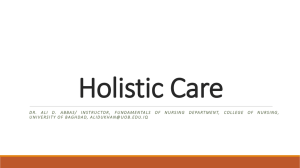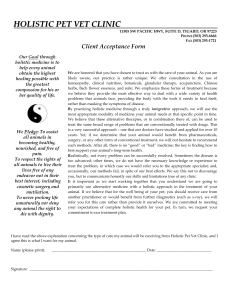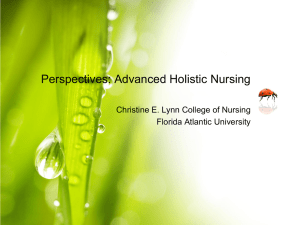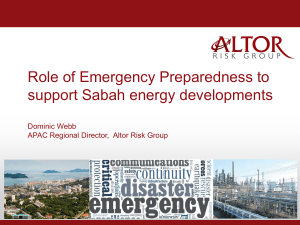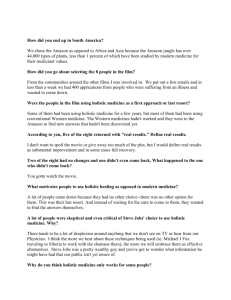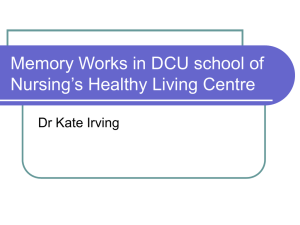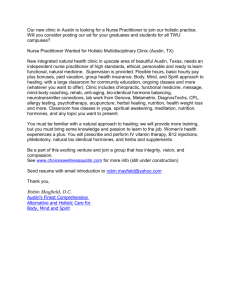exam handbook
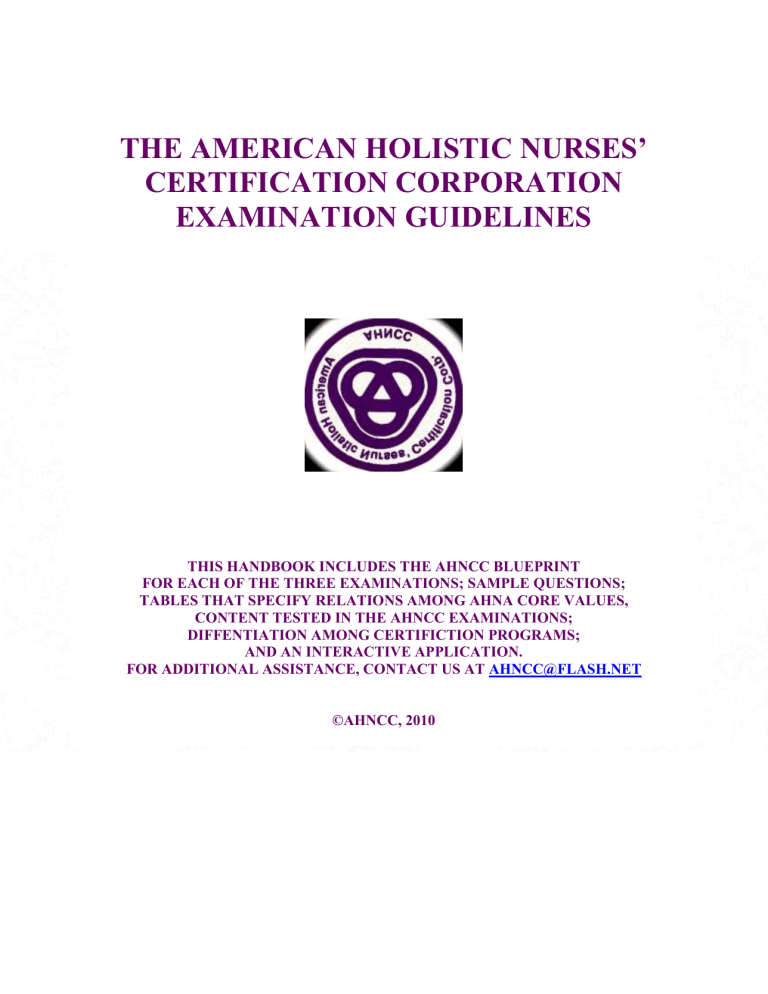
THE AMERICAN HOLISTIC NURSES’
CERTIFICATION CORPORATION
EXAMINATION GUIDELINES
THIS HANDBOOK INCLUDES THE AHNCC BLUEPRINT
FOR EACH OF THE THREE EXAMINATIONS; SAMPLE QUESTIONS;
TABLES THAT SPECIFY RELATIONS AMONG AHNA CORE VALUES,
CONTENT TESTED IN THE AHNCC EXAMINATIONS;
DIFFENTIATION AMONG CERTIFICTION PROGRAMS;
AND AN INTERACTIVE APPLICATION.
FOR ADDITIONAL ASSISTANCE, CONTACT US AT AHNCC@FLASH.NET
©AHNCC, 2010
AHNCC STUDY BLUEPRINT AND GUIDELINES
©AHNCC, NOVEMBER 2010
The following pages provide information about the content of the three AHNCC exams. There are four sections. Section 1) Table 1 was derived by the work of several groups of expert holistic nurses. Section 2) The Blue print, presented by level of examination with the five AHNA Core
Values listed below was extrapolated from the AHNA Scope and Standards for Holistic Nursing,
2006, reviewed by experts in holistic nursing, and approved by the AHNCC Board of Directors.
The number of items on each respective examination for each Core Value is shown; the percentage of the examination is also provided. Section 3) Sample questions for each level of examination are shown. Section 4) Table 2. Relations among three levels of exams, AHNA Core
Values, and AHNCC expectations for candidates. Pages may be printed for personal use only.
Section 1.
Table 1. Comparison of knowledge and skills by educational level
Diploma and Associate Baccalaureate Graduate
Ability to apply core concepts. For e.g.
Holism, Presence, Intentionality,
Unconditional Acceptance, Caring,
Healing, etc.
Ability to use research and theory in description, application, and analysis of core concepts.
Ability to design studies and analyze research findings related to the practice and advancement of
Holistic Nursing
Ability to create caring environments, empower clients, and design care plans that are mutually conducive to growth and health.
Ability to provide theoretically-based individual and family focused care using research findings.
Ability to provide sophisticated theoretically-based individual and family- focused care based on research findings.
Ability to provide leadership in the advancement of Holistic Nursing in limited settings.
Ability to provide leadership for other health-care providers in provision of theory-based, researchsupported care of the holistic person.
Ability to design and implement research activities that advance
Holistic Nursing knowledge.
2/9
AHNCC STUDY BLUEPRINT AND GUIDELINES
©AHNCC, NOVEMBER 2010
Section 2.
BLUEPRINTS FOR THE AHNCC EXAMINATIONS
The HN-BC Examination contains 150 items, organized by Core Value as follows:
1.
Holistic Philosophy, Theories, and Ethics: 38items (25% of the exam).
2.
Holistic Education and Research: 8 items (5% of the exam).
3.
Holistic Nurse Self-Care: 25 items (17% of the exam).
4.
Holistic Communication, Therapeutic Environment, and Cultural Diversity: 44 items (29% of the exam).
5.
Holistic Caring Process: 35 items (24% of the exam).
The HNB-BC Examination contains 171 items, organized by Core Value as follows:
1.
Holistic Philosophy, Theories, and Ethics: 44 items (26% of the exam).
2.
Holistic Education and Research: 24 items (14% of the exam).
3.
Holistic Nurse Self-Care: 23 items (14% of the exam).
4.
Holistic Communication, Therapeutic Environment, and Cultural Diversity: 47 items (27% of the exam).
5.
Holistic Caring Process: 33 items (19% of the exam).
The Graduate Exam contains 191 items, organized by Core Values as follows:
1.
Holistic Philosophy, Theories, and Ethics: 47 items (25% of the exam).
2.
Holistic Education and Research: 32 items (17% of the exam).
3.
Holistic Nurse Self-Care: 16 items (8% of the exam)
4.
Holistic Communication, Therapeutic Environment, and Cultural Diversity: 32 items (17% of the exam).
5.
Holistic Caring Process: 64 items (33% of the exam).
3/9
AHNCC STUDY BLUEPRINT AND GUIDELINES
©AHNCC, NOVEMBER 2010
Section 3.
Sample Quantitative
Exam Questions, HN-BC:
1) The term “healing” is best described by which of the following definitions: a.
A continual journey of self-changing and evolving. b.
The essence that permeates all of life, manifested in one’s being. c.
Return to the natural state of integrity and wholeness of an individual. d.
Activities that prevent illness and growth.
(C is correct. A is a good distracter, but is not correct. While it may describe the process, it does not indicate that growth is occurring.)
2) Which of the following is a responsibility of a holistic nurse? a.
Ensure that the client finds meaning in the illness. b.
Use true presence with a client to facilitate understanding of the client’s perception of the illness. c.
Establish rapport with client to get the client to understand and cooperate with the treatment regime. d.
Use true presence with client and force the nurse’s own problems into the background in order to focus on the tasks to accomplish.
(Answer B is correct. While A is an aim of Holistic Nursing, Holistic Nurses cannot ensure that this will happen immediately. Although some might be drawn to D, it does not describe the essence of presence or the reason for using presence).
Section 3. Continued
Sample Quantitative
Exam Questions,
HNB-BC
1) A 53 year old woman with recurrent breast cancer confides to a Holistic Nurse that she plans to stop her medical treatments that no longer seem to be helping her, and to try an herbal preparation a friend told her cures cancer. She says she does not plan to tell her family right away because they might be against her plan. Which of the following is the most appropriate action? a.
Accept her decision without question and say nothing more. b.
Tell her it would be best to talk with her doctor first. c.
Explore further with her what made her come to this decision. d.
Inform her family and physicians as soon as possible.
4/9
AHNCC STUDY BLUEPRINT AND GUIDELINES
©AHNCC, NOVEMBER 2010
(C is correct. Although holistic nurses support their client’s worldview, without further clarification, it is impossible to understand why she made this decision.
2) In a study of 156 women who have a history of childhood sexual abuse, a nurse found that there was a statistically significant correlation between the severity of the abuse and suicide attempts within the previous year. Based on this finding, a holistic nurse working with a group of women who have a history of childhood abuse should first: a.
Screen group participants for suicide risk. b.
Encourage group participants to describe their abuse. c.
Assure group participants of confidentiality. d.
Inform group participants of these research findings.
(A is correct. While c is a good distracter, given the research findings, the Holistic Nurse is ethically responsible to further assess group participants to determine their risk status.)
Section 3. Continued
Sample Quantitative
Exam Questions,
AHN-BC
1. Which of the following is the rationale for individualized, supportive nursing interventions for clients experiencing pain? a.
Eliminate the need for medication to manage pain. b.
Interrupt acting out behaviors related to pain experiences. c.
Reduce the sense of helplessness and increase the sense of control. d.
Avoid reactivating repressed or unresolved past emotional experiences.
(Answer C is correct. Holistic Nurses aim to empower their clients. This in turn, facilitates them in separating psychic pain from physical pain, altering their output of neurotransmitters.)
2. Which of the following explains the current research findings of psychophysiology responses? a.
A web-like pattern locked between the frontal cortex, limbic system, and hypothalamus. b.
A loop starting from sensory organs to thalamus to cortex to limbic system and back to body response. c.
The hypothalamus-pituitary-adrenal axis controls secretion of glucocorticoids for the suppression of immune cell response. d.
Neurotransmitters carry messages to receptor sites throughout the bodymind, stimulating release of hormones that influence emotional states as well as immune integrity.
(Answer D is correct.)
5/9
AHNCC APPLICATION FORM, HOLISTIC NURSE CERTIFICATION PROGRAM
VALUE PHILOSOPHY,
THEORY &
ETHICS
HN-BC
HNB-BC Demonstrates ability to:
•Articulate the relationship between healing and caring concepts.
•Discuss and describe relations among core
Holistic
Nursing concepts e.g. holism, presence, intentionality, unconditional acceptance, caring, healing, etc., and selected extant
Holistic
Nursing
Demonstrates ability to:
•Articulate the relationship between caring and healing.
•Discuss and describe core
Holistic
Nursing concepts (e.g. holism, presence, intentionality, unconditional acceptance, caring, healing, etc., and
•Explain how they are used in personal and professional lives.
EDUCATION &
RESEARCH
Demonstrates desire and ability to advance personal understanding and expertise of
Holistic Nursing through
Demonstrates:
•Continued growth in expertise of
Holistic
Nursing.
•Ability to facilitate others in advancing their understanding of Holistic
Nursing.
•Ability to apply research findings in the practice of
Holistic
Nursing.
Section 4.
Table 2. Relations among AHNA Core Values, three levels of AHNCC Certification Program, and expectations for certified holistic nurses
CORE 1. HOLISTIC 2. HOLISTIC 3. HOLISTIC 4. HOLISTIC 5. HOLISTIC
SELF-CARE
Demonstrates ability to apply concepts of selfcare to self and others.
Demonstrates ability to facilitate self and others in advancement and application of self-care concepts/actions.
COMMUNICATION,
THERAPEUTIC
ENVIRONMENT AND
CULTURAL
DIVERSITY
Demonstrates ability to create caring environments that are culturally sensitive and conducive to mutual growth and healing in client and nurse.
Demonstrates ability to use culturally competent communication skills and techniques in the creation of caring environments.
CARING
PROCESS
Demonstrates ability to apply:
•Conceptually based holistic nursing to individuals, families, and groups, and
•Selected research findings in the various phases of the caring process.
Demonstrates ability to provide:
•Theoreticallybased individual, family, group, & community care using research findings, and
•Leadership in the advancement of Holistic
Nursing in limited settings.
6/9
AHNCC APPLICATION FORM, HOLISTIC NURSE CERTIFICATION PROGRAM theories, and
•explain how they are used in one’s personal and professional lives.
AHN-BC Demonstrates ability to provide leadership in the application, analysis, synthesis, and evaluation of
Holistic Nursing concepts and theories.
Demonstrates:
•Continued growth in expertise of
Holistic
Nursing.
•Ability to provide mentorship and leadership in the advancement of
Holistic
Nursing.
•Ability to design studies and analyze research findings related to the practice and advancement of
Holistic
Nursing.
Demonstrates ability to:
•Synthesize and evaluate self-care concepts and actions, and
•Provide leadership in the advancement of self-care in the health-care arena.
Demonstrates ability to:
•Provide leadership in the creation and use of therapeutic environments, and
•Mentor others in the acquisition of cultural competence.
Demonstrates ability to:
•Provide sophisticated theoreticallybased, holistic care to clients incorporating appropriate research findings,;
•Synthesize clinical cases to evaluate nursing care effectiveness;
•Evaluate caring and healing activities in the nursing process, and
Provide leadership for other health-care providers in provision of theory-based, researchsupported care.
Suggested References for Certification
Achterberg, J., Dossey, B., & Kolkmeier, L. (1994). Rituals of Healing. New York, NY: Bantam Books.
Alligood, M. R. & Tomey-Mariner, A. (2006). Nursing Theory:Utilization and Application (3 rd edition). NY:
Mosby
Dossey, B., Keegan, L., Guzzetta, C., and Kolkmeier, L. (2005). Holistic Nursing: A Handbook for Practice (5th edition). Gaithersburg, MD: Aspen Publishers.
Dossey, L. (1997). Healing Words. San Francisco, CA: Harper Collins.
Erickson, H., Tomlin, E., Swain, M.A. (1996). Modeling and Role-Modeling: A Theory and Paradigm for
Nursing. Austin, Tx; EST Publishers, Inc.
Erickson, H. (ed.) (2006). Modeling and Role-Modeling: A View From the Client’s World. Cedar Park, TX:
Unicorns Unlimited Publishing.
Frisch, N. & Kelly, J. (1995). Healing Life's Crises. Albany, NY: Delmar Publishers, Inc.
Gaut, D.A., & Boykin, A. (Eds.). (1994). Caring as Healing: Renewal Through Hope. New York: National League for Nursing Press.
George, J. (2005). Nursing Theories: The Base for Professional Practice. (5 th ed.) NY:Prentice Hall
Goldberg, B. Group. (2002). Alternative Medicine: The Definitive Guide, Puyallup, WA: Future Medicine
Publishing,
7/9
AHNCC APPLICATION FORM, HOLISTIC NURSE CERTIFICATION PROGRAM
Hover-Kramer, D., Mentgen, J., and Scandrett-Hibdon, S. (1995) Healing Touch: A Resource for Health Care
Professionals, Albany, NY: Delmar Publishers, Inc.
Hover-Kramer, D. and Shames, K. (1997). Energetic Approaches to Emotional Healing, Albany, NY: Delmar
Publishers, Inc.
Journal Of Holistic Nursing, Official Journal of the American Holistic Nurses' Association: Sage Periodicals Press,
A Division of SAGE Publications, Inc., Thousand Oaks, CA.
Kahn, S. (1996). The Nurse's Meditative Journal. Albany, NY: Delmar Publishers, Inc.
Keegan, L. (1993). The Nurse as Healer. Albany, NY: Delmar Publishers, Inc.
Keegan, L. (2001). Healing Nutrition. Albany, NY: Delmar Publishers, Inc.
Keegan, L. & Dossey, B. (1997) Profiles of Nurse Healers. Albany, NY: Delmar Publishers, Inc.
Mariner-Tomey, A. & Alligood, M. R. (6 th edition) (2006). Nursing Theorists and Their Work. NY: Mosby
Micozzi, M. (ed.) (2001). Fundamentals of Complementary and Alternative Medicine London, England: Churchill
Livingstone, Inc.
Newman, M. A. (1994). Health as expanding consciousness, 2nd.edition/ NY: National League for Nursing Press.
Olson, M. (2001). Healing the Dying. Albany, NY: Delmar Publishers, Inc.
Parse, R/ R/ (1981). Man-Living-Health: A theory of nursing. New York: Wiley.
Pizzorno, J. (1997). Total Wellness. Rocklin, CA: Prima Publishing.
Rew, L. (1995). Awareness in Healing. Albany, NY: Delmar Publishers, Inc.
Madrid, M. (Ed.)(1997). Patterns of Rogerian knowing. NY: National League for Nursing Press.
Rogers, M. E. (1992). Nursing science and the space age. Nursing Science Quarterly, 5, 27-34.
Rogers, M. E. (1986). Science of unitary human beings. In V.
Malinski (Ed.), Explorations on Martha Rogers' Science of unitary human beings (pp. 3-8). Norwalk, CT:
Appleton-Century-Crofts.
Shames, K. (1996). Creative Imagery in Nursing. Albany, NY: Delmar Publishers, Inc.
Umlauf, M.G. (1996). Healing Meditation. Albany, NY: Delmar Publishers, Inc.
Watson, J. (1988). Nursing: Human science and human care. NY: National League for Nursing Press.
Suggested Videos and Audiocassettes for Certification Preparation :
Holistic Nursing (video) Contact: American Holistic Nurses Association (AHNA) 1-800-278-AHNA
At the Heart of Healing:Experiencing Holistic Nursing (video)Contact: Kineholistic Foundation, PO Box 719,
Woodstock, NY, 12398 (800) 255-1914, X 277
A Conversation on Caring with Jean Watson and Janet Quinn Contact: National League for Nursing Press, 350
Hudson Street, New York, NY, 10014 (800) 669-9656, ext. 138
The Art of Caring: Holistic Healing using Relaxation, Imagery, Music and Touch (by Barbara Dossey, Lynn
Keegan, and Cathie Guzzetta) (Four, one hour audiocassettes with booklet and CEU option) Contact: Sounds True, 413 S.
Arthur Ave., Louisville, CO 80027 (800) 333-9185
8/9
AHNCC APPLICATION FORM, HOLISTIC NURSE CERTIFICATION PROGRAM
9/9
